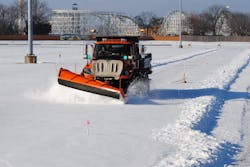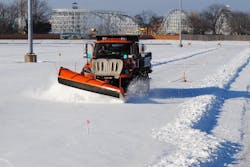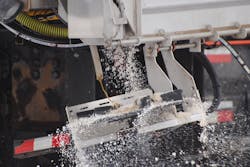Everyone’s a scientist
Clearing snow from roadways is an effort as old as roadways themselves, at least in cold climates.
Truck-mounted plows came into wide use in the 1920s. Abrasives such as sand, coal bottom ash or clinker were used to increase friction on icy roadways, once plowed. During the winter of 1941-42, New Hampshire became the first state to establish a systematic use of salt for deicing. About 1 million tons of salt were used per year for deicing in 1950; by 1970, 10 million tons per year were being used, an amount that has remained consistent though adjusted by winter-to-winter variation according to the U.S. Geological Survey. The rapid increase of salt usage from 1950-1970 coincides with the rise of driver expectation for bare pavements during any winter conditions (other than storm events).
Deicer distribution techniques on roadways have progressed from basic to quite advanced over time:
- 1940s: Stationing of a shoveler in the back of a dump truck;
- 1950s: Installation of a spinner plate below a gravity-fed chute for full roadway broadcast;
- 1970s: Distribution through a smaller spinner plate or line drop onto high side of travel lane to encourage undercutting of ice through brine drainage;
- 1980s: Incorporation of pre-wetting treatment on granular deicer to improve roadway adherence and resistance to bounce or blow-off;
- 1990s: Introduction of pre-storm chemical treatment of pavements to anti-ice;
- 2000s: Matching deicer spreading technologies with “smart vehicle” techniques such as maintenance decision support system (MDSS), automated vehicle location (AVL) and road weather information systems (RWIS); and
- 2010s: Introduction of brine-blending systems and multi-component liquid chemical systems.
Deicing material selection has been a consideration constant since the introduction of deicing as a technique, as cost-benefit analyses have accompanied the use of rock salt (bulk-mined sodium chloride), solar salt (evaporated remains of solution mined or sea water-originated salt), magnesium chloride, calcium chloride, acetates, alcohols, carbohydrates and any other product available in bulk that can reduce the freeze point of water.
Finding the treasure trove
Roadway deicing and snow removal has a rich tradition of observational science, both during operational aspects and in stand-alone research studies. The scientific method (formulate hypothesis, predict outcome, test outcome and analyze results) is a vibrant presence in the cab of every plow truck, as operators study storm events, plan their deicing efforts, plow and spread deicer, then review the outcome perhaps 60 minutes later on a following pass of a plow truck route. Every driver who repeats a route is immediately confronted with comparisons, whether between the current pass and the previous one, the current storm and the last one, or the current winter and the coldest/stormiest/biggest winter in past memory.
While drivers are a treasure trove of results, the difficulty comes with comparison between locations or even geographies. If it “plays in Peoria,” will the same technique play with a dry ground blizzard in Minnesota, wet Nor’easter snow in Maine, or deep mountain-pass snow in Colorado? Sometimes, the question is simpler: Will a given technique work as well on the back side of a hill, where the sun may not shine at quite the same angle or the wind blows a bit colder?
Even further is the need for comparisons across exactly similar conditions, a tough call when weather changes quickly, the sun moves throughout the day, traffic comes and goes, and slight variations in wind can cause big differences in snow character.
Experimental phase
Minnesota State University at Mankato, in collaboration with the Minnesota Department of Transportation, has developed a series of experimental units in three different settings, broadly grouped as:
- Temperature-controlled (-30°F to 30°F) laboratory specimens:
- Ice coupons; and
- Pavement patches.
- Natural weather, controlled traffic-dedicated pavement areas:
- Test lanes, 1,000 ft long for plowing, deicing and traffic up to 35 mph;
- Test strips, 50 ft long by one lane width; and
- Test lines (compacted snow wheel line).
- Actual roadway sections on elevated highway:
- Roadway lanes: passing lane, travel lane, ramp merge area, shoulders;
- Northbound and southbound;
- Defined pavement drainage area; and
- Off-road underlying area, plow cast deposition zone.
These experimental units allow side-by-side comparisons to determine the effectiveness of various approaches. Chloride measurements in melt waters or drainage are helpful, but simple observations by eye provide most of our results. Time-lapse photography using “game cameras” or a single-lens reflex digital camera with a telephoto lens worked well to document plowing and melting conditions, at least during daylight hours. Thermal imagery, expensive but detailed, provided a nuanced look at melt mechanics by salt deicers in particular. Ice base creation procedures were developed but remain somewhat difficult to do on actual (non-laboratory) pavements in winter conditions without a ready supply of cold water.
Civil engineers designed winter maintenance experiments around the observations reported by operators in an effort to document benefits and assess improvement in effectiveness.
Complete evaluations
Tests are done not by experts in plowing or deicing, but by civil engineers working in a laboratory or field setting. So how are factors identified for testing? By listening to operators, particularly when probed with questions about preferred techniques and why the operators think they work. Discussions between operators or groups of operators from different truck stations have yielded significant benefits about factors of uncertain effect. Civil engineers then design experiments around the observations reported by the operator, in an effort to document benefits and assess improvement in effectiveness.
Evaluations performed have included:
- Ice melt capacity by deicer, deicer plus pre-wet and temperature;
- Activation speed of deicers;
- Solar enhancement of deicing by salt coloration;
- Pre-wet improvement to melt initiation;
- Pre-wet bounce inhibition;
- Anti-icer persistence by precipitation amount and pavement type;
- Chloride removal by plow cast;
- Deicier performance by application rate;
- Enhancement of deicing by pre-wet application;
- Enhancement of deicing by traffic application, type and amount;
- Variation in plow performance by plow type, material and truck speed;
- Variation in clouding around plows by plow type and truck speed; and
- Variation in plow performance and deicing by snow characteristics.
Lab results
A wide variety of chemical treatments are now available for deicing. In laboratory studies, over 50 deicer and anti-icer compounds and compound blends were evaluated for ice melt capacity in over 1,400 determinations, at temperatures ranging from 30°F to -30°F. Values of ice melt capacity ranged from zero (no melting caused) to 12.7 mL brine created/g of deicer (or mL of deicer brine) applied, and were generally found to be strongly associated with temperature. Warmer is almost always better.
Ionic concentration also is a factor for which higher is better at ice melt concentration, which is why the magnesium and calcium chloride products (with two chloride ions per molecule) have higher ice melt capacities than sodium chloride products with only one chloride ion per molecule. Ionic concentration also is why salts outperform sugars and carbohydrates such as those derived from corn or soybean residuals.
Because of its widespread use and relative low cost, rock salt (mined sodium chloride) was selected for use during all field evaluations. Rock salt has an ice melt capacity of 8 when applied at 28°F, 4 at 20°F, and zero at 12°F.
Deicer pre-wet and traffic effect testing
Pavement treatments were evaluated for deicers with pre-wets, application of traffic, and traffic-timing effects. Not using a pre-wet on deicer materials made a substantial and significant difference when attempting to deice in very dry snow conditions, even though the temperatures were considered warm (35°F). On a colder day (25°F) but with moist snow conditions, pre-wetting deicer seemed to make little difference. Deicing efficiency and effectiveness were observed to be greater with damper conditions (either natural moisture or pre-wet moisture when the snow is very dry), which is interpreted as moisture improving the activation and migration of the chloride through the snow structure for broader distribution of the deicing effects.
Truck traffic applied to a snow/ice surface after a deicer application was found to provide a modest improvement when the snow condition was very dry, and a substantial improvement when the snow condition was moist. The improvement generally took the form of open pavement areas forming sooner and becoming wider than without the traffic condition. As noted during a previous study from the winter of 2015-16, truck traffic appears to improve the contact area of the solid deicer and allow the solid to reach more of the water matrix for the ionic separation of the solid material, with the concurrent lowering of the melt point.
Car traffic was found to provide similar benefits to truck traffic, but to a lesser extent.
Delay in traffic application after deicer distribution showed conflicting results, most likely dependent upon the snow moisture condition.
With dry snow, delay-of-traffic application may slightly increase the improvement to deicing of the traffic, as tread churn and tire spray occurs when the deicer has become activated in moisture created by melted snow and ice. It appears that the dry snow needs some time to develop moisture for the deicer to work, and the delayed tread churn and tire spray promotes distribution of activated (moistened) deicer.
With moist snow, a delay-of-traffic application may slightly reduce the traffic improvement to deicing of the traffic, interpreted as tread churn, and tire spray applied earlier promotes the distribution of the deicer while the deicer is fully effective, prior to the deicer being solubilized into the snow or ice structure and used up.
Any potential interaction between the use of pre-wetting and the application of truck traffic for moist snow conditions appeared to be dominated by the improvement due to truck traffic; no specific interaction benefit is identified. However, it was hypothesized that the interaction of truck traffic with the use of a pre-wet for very dry snow conditions would likely demonstrate substantial benefit.
Pavement treatments were evaluated for deicers with pre-wets, application of traffic and traffic-timing effects. Not using a pre-wet on deicer materials made a substantial and significant difference when attempting to deice in very dry snow conditions.
Getting it to melt
Pavements were studied for dissolved solids response in runoff during precipitation events after applications of different deicer materials. Total dissolved solids concentrations were similar across all evaluated tests, starting at relatively high levels, rising up sharply to a peak concentration of around 8% concentration typically by 0.02 in. precipitation, then declining quickly to a low residual concentration by perhaps 0.12 in. precipitation where the concentration remained steady with increasing precipitation. The decline was interpreted as flushing out the chloride and other dissolved materials, and would likely result in a runoff that would freeze near the pure water freeze point of 32°F.
Cumulative totals of dissolved solids also were similar across all evaluated tests, increasing quickly during the initial precipitation, then slowing the increase and reaching to a deicer-specific maximum level. Tests performed with other anti-icer mixtures and variations on organic content and composition suggested that the total dissolved solids and the cumulative dissolved solids have similar behaviors no matter what the mixture, only the magnitudes differed.
Moisture condition on the pavement surface may well be a substantial factor in determining anti-icing success, supporting previously developed ideas. Some persistence benefit was observed to be derived from increasing organic content within the anti-icer mixture.
Deicers also were studied for melt initiation and expansion characteristics. Finer-sized deicers appeared to initiate melt faster than coarser-sized deicers of the same material, interpreted as melt initiating over a broader area related to the increased amount of total grain-to-ice contact area for the finer-sized deicers. Melt expansion appeared to have differing mechanisms for the fine and coarse deicers, as coarse particles penetrated far into the ice sheet while fine particles acted predominantly on the surface of the ice sheet. Wind blow and bounce would, of course, affect the deicer differently, depending upon the grain size.
Temperature did not seem to be a factor in the speed of either the melt initiation or the melt expansion, other than as caused by the change in ice melt capacity between different temperatures. Pre-wetting the deicer did not appear to affect the melt initiation, although the lack of behavioral difference may be caused by the high moisture content of the ice sheet used for testing, rather than the lower moisture content associated with some compacted snow material.
Cast, clouding, cut (scrape quality), and compaction were evaluated and documented for individual plows under a given set of conditions: differing speeds, differing locations with different snow structure, and at differing snow moisture and temperature conditions. Similarities and differences were considered for the range of plow types, but limited patterns were identified suggesting factors not yet isolated may be playing significant roles.
Strong comparisons
The need for both effectiveness and efficiency in winter roadway maintenance has every plow operator, maintenance supervisor and roadway driver making evaluations about plow and deicer performance. By creating a framework for side-by-side comparisons, best practices can be determined across temperature, snow, sun, moisture, traffic, pavement and wind variations. Empowering winter maintenance personnel to be scientists, benefits can be realized in a triple bottom line of reduced costs, less labor and more efficient equipment use, plus improved environmental protection through lowered chloride use.


